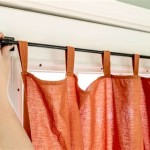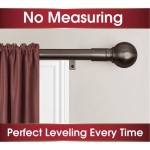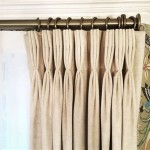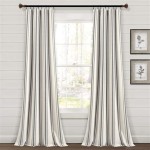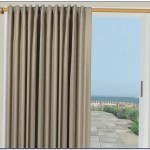Understanding Curtain Rod Brackets: A Comprehensive Guide to 1-Inch Options
Curtain rod brackets are essential hardware components that provide support for curtain rods, enabling the hanging of curtains, drapes, and valances. When selecting curtain rod brackets, understanding the different types, materials, features, and installation methods is crucial to ensuring proper functionality and aesthetic appeal. This article focuses specifically on 1-inch curtain rod brackets, offering a detailed overview of their applications, advantages, and considerations.
The term "1-inch" in relation to curtain rod brackets typically refers to the inner diameter of the bracket's opening, which is designed to accommodate a curtain rod with a 1-inch outer diameter. This dimension is a common standard for many decorative and functional curtain rods, making 1-inch brackets a widely available and versatile option for various window treatment applications.
Key Considerations When Choosing 1-Inch Curtain Rod Brackets
Selecting the right 1-inch curtain rod brackets involves several factors, including the weight of the curtains, the material of the bracket, the mounting surface, and the desired aesthetic. Failing to consider these aspects can lead to improperly supported curtain rods, sagging curtains, or even damage to the wall.
Weight Capacity: The weight capacity of a curtain rod bracket is paramount. Heavy drapes or multiple layers of fabric require robust brackets capable of supporting the load without bending or breaking. Manufacturers typically specify the weight capacity of their brackets, and it's essential to choose brackets that exceed the estimated weight of the curtains to provide a safety margin. For lighter curtains, such as sheers or lace panels, lighter-duty brackets may suffice. However, it's always prudent to err on the side of caution and opt for brackets with a higher weight capacity than initially anticipated.
Material: Curtain rod brackets are manufactured from a variety of materials, each offering different strengths, durability, and aesthetic qualities. Common materials include steel, wrought iron, brass, aluminum, and plastic. Steel and wrought iron are known for their strength and durability, making them suitable for supporting heavy curtains. Brass offers a classic and elegant look and is often used in more decorative applications. Aluminum is lightweight and corrosion-resistant, making it a good choice for areas with high humidity. Plastic brackets are typically the least expensive option but may not be as durable or suitable for heavy curtains.
Mounting Surface: The type of wall or surface on which the brackets will be mounted plays a significant role in bracket selection. Drywall, plaster, wood studs, and masonry each require different types of mounting hardware and techniques. For drywall, using drywall anchors is essential to provide sufficient support. Always locate and use wall studs whenever possible, especially for heavier curtains. For masonry walls, specialized masonry anchors are necessary. Failing to use the correct mounting hardware can result in the brackets pulling out of the wall, causing damage and potentially creating a safety hazard.
Types of 1-Inch Curtain Rod Brackets
Numerous types of 1-inch curtain rod brackets are available, each designed for specific purposes and mounting configurations. Understanding the different types can help in selecting the most appropriate brackets for a given application.
Standard Brackets: Standard brackets are the most common type and typically consist of a single arm that extends from the wall to support the curtain rod. They are generally used in pairs, one at each end of the rod, and may be available in various lengths to accommodate different curtain projections from the wall. Standard brackets are suitable for most standard curtain installations.
Center Support Brackets: For wider windows or heavier curtains, a center support bracket is often necessary to provide additional support to the curtain rod and prevent sagging. Center support brackets are typically mounted in the middle of the window and feature a similar design to standard brackets but are specifically designed to support the rod in the center. The use of a center support bracket is crucial for ensuring the longevity and stability of the curtain rod installation.
Adjustable Brackets: Adjustable brackets offer flexibility in terms of projection from the wall. They allow users to adjust the distance between the curtain rod and the wall, which can be useful for accommodating window obstructions or creating different layering effects with curtains. Adjustable brackets are particularly helpful when dealing with uneven walls or windows that are not flush with the wall surface.
Ceiling Mount Brackets: Ceiling mount brackets are designed to be mounted directly to the ceiling, providing a unique and often dramatic curtain hanging solution. These brackets are typically used when wall mounting is not feasible or when a floor-to-ceiling curtain arrangement is desired. Ceiling mount brackets require careful installation to ensure they are securely attached to the ceiling joists or using appropriate ceiling anchors.
Wrap-Around Brackets: Wrap-around brackets are designed to curve around the sides of the window, blocking more light and providing greater privacy. They are particularly effective in bedrooms or media rooms where light control is a primary concern. Wrap-around brackets can also enhance the insulating properties of curtains by minimizing drafts around the edges of the window.
Installation Considerations for 1-Inch Curtain Rod Brackets
Proper installation is crucial for ensuring the safety and functionality of 1-inch curtain rod brackets. Taking the time to plan and execute the installation carefully can prevent future problems and ensure the longevity of the curtain rod installation.
Measuring and Marking: Accurate measuring and marking are essential for ensuring that the brackets are installed at the correct height and distance apart. Use a level to ensure that the brackets are aligned horizontally. Marking the screw holes precisely will facilitate accurate drilling and prevent misaligned brackets.
Pilot Holes: Drilling pilot holes before installing screws is highly recommended, especially when working with hard materials like wood or plaster. Pilot holes prevent the wood from splitting and make it easier to drive the screws straight and securely. The size of the pilot hole should be slightly smaller than the diameter of the screw.
Using Anchors: When mounting brackets on drywall, using drywall anchors is essential to provide sufficient support. There are various types of drywall anchors available, including plastic anchors, self-drilling anchors, and metal anchors. Select the appropriate type of anchor based on the weight of the curtains and the thickness of the drywall. Ensure that the anchors are properly installed according to the manufacturer's instructions.
Leveling and Securing: After installing the brackets, use a level to ensure that they are perfectly level. Tighten the screws securely, but avoid over-tightening, which can strip the screw holes or damage the wall. If the brackets are not level, adjust them accordingly before fully tightening the screws.
Testing the Stability: Once the curtain rod is installed, test its stability by gently pulling on it. If the rod feels wobbly or insecure, re-tighten the screws or consider using stronger anchors. If necessary, add a center support bracket for additional stability, especially for wider windows or heavier curtains.
Aesthetic Considerations: Beyond functionality, the aesthetic appeal of curtain rod brackets is also important. Choose brackets that complement the style of the curtains and the overall decor of the room. Brackets are available in a wide range of finishes, including brushed nickel, oil-rubbed bronze, black, and white. Selecting a finish that coordinates with other hardware in the room, such as door handles and light fixtures, can create a cohesive and polished look.
In summary, selecting and installing 1-inch curtain rod brackets requires careful consideration of several factors, including weight capacity, material, mounting surface, and installation techniques. By understanding the different types of brackets available and following proper installation procedures, it is possible to create a functional and aesthetically pleasing window treatment that will last for years to come.

Loop Eyelet Bracket For 1 Curtain Rods Each

Urbanest Curtain Rod Bracket Adjustable Fits 1 4 Bronze Wal Com

Ceiling Mounted Curtain Rod Brackets Heavy Duty Bracket For 1 Inch L8b1

Urbanest Adjustable Curtain Rod Bracket Up To 1 8 Inch Diameter

Adjustable Single Curtain Rod Brackets 1 In 4 Piece Lumi Home Furnishings

Rod Desyne Black Metal Double 6 In Projection Curtain Bracket Set Of 2 1913 012 The Home

Hequsigns Adjustable Curtain Rod Brackets 3 Pack Drapery Holders Heavy Duty Hanging Extendable Wall Mounted Metal Single Bracket For 1 Inch Black Wal Com

Curtain Rod Bracket Heavy Duty Holders Single Decorative Windowrod

Single Decorative Brackets For 1 3 8 Inch Thick Curtain Rods Poles C The Drapery King Toronto
-616x616h.jpg.webp?strip=all)
Curtain Rod Holder Heavy Double Support Bracket
See Also

